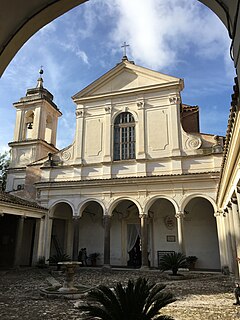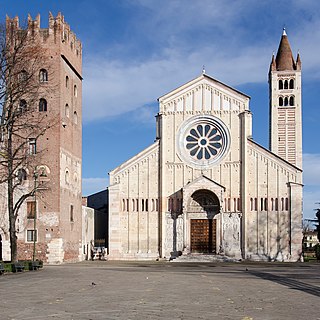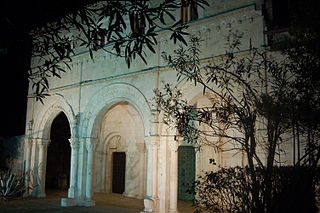
Romanesque architecture is an architectural style of medieval Europe characterized by semi-circular arches. There is no consensus for the beginning date of the Romanesque style, with proposals ranging from the 6th to the 11th century, this later date being the most commonly held. In the 12th century it developed into the Gothic style, marked by pointed arches. Examples of Romanesque architecture can be found across the continent, making it the first pan-European architectural style since Imperial Roman architecture. The Romanesque style in England is traditionally referred to as Norman architecture.

The Basilica of Saint Clement is a Latin Catholic minor basilica dedicated to Pope Clement I located in Rome, Italy. Archaeologically speaking, the structure is a three-tiered complex of buildings: (1) the present basilica built just before the year 1100 during the height of the Middle Ages; (2) beneath the present basilica is a 4th-century basilica that had been converted out of the home of a Roman nobleman, part of which had in the 1st century briefly served as an early church, and the basement of which had in the 2nd century briefly served as a mithraeum; (3) the home of the Roman nobleman had been built on the foundations of republican era villa and warehouse that had been destroyed in the Great Fire of 64 AD.

Nonantola Abbey, dedicated to Saint Sylvester, is a former a Benedictine monastery and prelature nullius in the commune of Nonantola, c. 10 km north-east of Modena, in the Emilia Romagna region of Italy. The abbey church remains as a basilica and is the co-cathedral of the diocese of Modena-Nonantola.

The Abbey of Sant'Antimo, Italian: Abbazia di Sant'Antimo, is a former Benedictine monastery located in Castelnuovo dell'Abate, in the comune of Montalcino, Tuscany, central Italy. It is approximately 10 km from Montalcino about 9 km from the Via Francigena, the pilgrim route to Rome. After many years of disuse, the abbey was reoccupied in 1992 by a small community of Premonstratensian Canons Regular. Since January 2016, the occupants are a community of monks of the Olivetan Benedictine order.

The Basilica di San Zeno is a minor basilica of Verona, Northern Italy constructed between 967-1398 AD. Its fame rests partly on its Romanesque architecture and partly upon the tradition that its crypt was the place of the marriage of Shakespeare's Romeo and Juliet. It stands adjacent to a Benedictine abbey, both dedicated to St Zeno of Verona.

San Liberatore a Maiella is an abbey and church in the territory of Serramonacesca, in the province of Pescara, region of Abruzzo, Italy.

The Abbey of San Clemente a Casauria is an abbey in the territory of Castiglione a Casauria, in the province of Pescara, Abruzzo, central Italy.

The Basilica of Sant'Abbondio is a Romanesque-style 11th-century Roman Catholic basilica church located in Como, region of Lombardy, Italy.

Millstatt Abbey is a former monastery in Millstatt, Austria. Established by Benedictine monks about 1070, it ranks among the most important Romanesque buildings in the state of Carinthia. The Benedictines were succeeded by the knightly Order of Saint George in 1469 and the Society of Jesus in 1598.

Novalesa Abbey is a Benedictine monastery in the Metropolitan City of Turin, Piedmont, Italy. It was founded in 726, and dedicated to Saint Peter and Saint Andrew.

Sant Serni de Tavèrnoles is a Romanesque Benedictine monastery in Anserall, in the municipality of Les Valls de Valira, Alt Urgell, in the Province of Lleida, Catalonia, Spain. It became a Bien de Interés Cultural site on 3 June 1931 and was restored in 1971.

The Abbey of San Cassiano is a former Benedictine monastery, located on Monte Santa Croce, outside of the town of Narni in the Province of Terni, in the Region of Umbria in Italy.

The Abbey of St. Peter in Assisi, Italy, is inhabited by a small community of monks belonging to the Benedictine Cassinese Congregation. They live according to the Rule of St. Benedict, summarized as "Ora et Labora".
Santa Maria di Propezzano is a Romanesque-style, former-Benedictine abbey and church located along Strada Provinziale 22C, in the Vomano valley, near the hamlet of Morro D'Oro, in the province of Teramo, region of Abruzzo, Italy.

The Abbey of Montesanto or Abbazia di Santa Maria in Montesanto is Romanesque-style Benedictine monastery located in the rural hills outside the town of Civitella del Tronto, in the province of Teramo, Abruzzo, Italy.
The Abbey of San Biagio was a former Roman Catholic monastery located in a rural site in the village of Piobbico, within the limits of the commune of Sarnano, in the province of Macerata, region of Marche, Italy. Of the abbey, only the church, dedicated to St Blaise, and a small monastic apartment remain.

The Abbey of San Lorenzo is a Roman Catholic basilica church, formerly part of a Benedictine monastery, located on Via San Demetrio #4 in San Lorenzo in Campo, province of Pesaro e Urbino, region of Marche, Italy. It was elevated to a basilica church in 1943 by basilica by Pope Pius XII.

Romanesque architecture appeared in France at the end of the 10th century, with the development of feudal society and the rise and spread of monastic orders, particularly the Benedictines, which built many important abbeys and monasteries in the style. It continued to dominate religious architecture until the appearance of French Gothic architecture in the Ile-de-France between about 1140-1150.

















